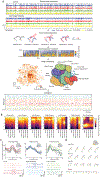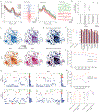Continuous Whole-Body 3D Kinematic Recordings across the Rodent Behavioral Repertoire
- PMID: 33340448
- PMCID: PMC7864892
- DOI: 10.1016/j.neuron.2020.11.016
Continuous Whole-Body 3D Kinematic Recordings across the Rodent Behavioral Repertoire
Abstract
In mammalian animal models, high-resolution kinematic tracking is restricted to brief sessions in constrained environments, limiting our ability to probe naturalistic behaviors and their neural underpinnings. To address this, we developed CAPTURE (Continuous Appendicular and Postural Tracking Using Retroreflector Embedding), a behavioral monitoring system that combines motion capture and deep learning to continuously track the 3D kinematics of a rat's head, trunk, and limbs for week-long timescales in freely behaving animals. CAPTURE realizes 10- to 100-fold gains in precision and robustness compared with existing convolutional network approaches to behavioral tracking. We demonstrate CAPTURE's ability to comprehensively profile the kinematics and sequential organization of natural rodent behavior, its variation across individuals, and its perturbation by drugs and disease, including identifying perseverative grooming states in a rat model of fragile X syndrome. CAPTURE significantly expands the range of behaviors and contexts that can be quantitatively investigated, opening the door to a new understanding of natural behavior and its neural basis.
Keywords: animal tracking; autism; behavior; computational ethology; grooming; individuality; motion capture; phenotyping.
Copyright © 2020 Elsevier Inc. All rights reserved.
Conflict of interest statement
Declaration of Interests The authors declare no competing interests.
Figures







References
-
- Agarwal A, and Triggs B (2004). Tracking Articulated Motion Using a Mixture of Autoregressive Models In Computer Vision - ECCV 2004, Pajdla T, and Matas J, eds. (Berlin, Heidelberg: Springer Berlin Heidelberg; ), pp. 54–65.
-
- Alahi A, Goel K, Ramanathan V, Robicquet A, Fei-Fei L, and Savarese S (2016). Social lstm: Human trajectory prediction in crowded spaces. In Proceedings of the IEEE Conference on Computer Vision and Pattern Recognition, pp. 961–971.
-
- Anderson DJ, and Perona P (2014). Toward a science of computational ethology. Neuron 84, 18–31. - PubMed
-
- Angel E (2009). The piercing bible : the definitive guide to safe body piercing (Berkeley, Calif: Celestial Arts; ).
Publication types
MeSH terms
Grants and funding
LinkOut - more resources
Full Text Sources
Other Literature Sources

